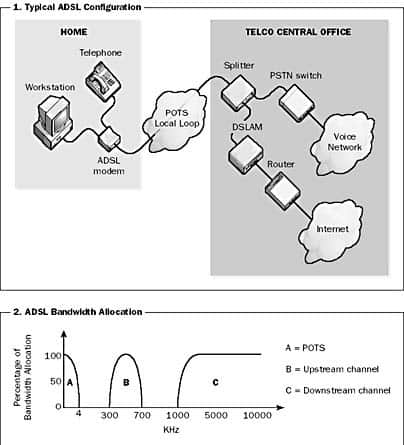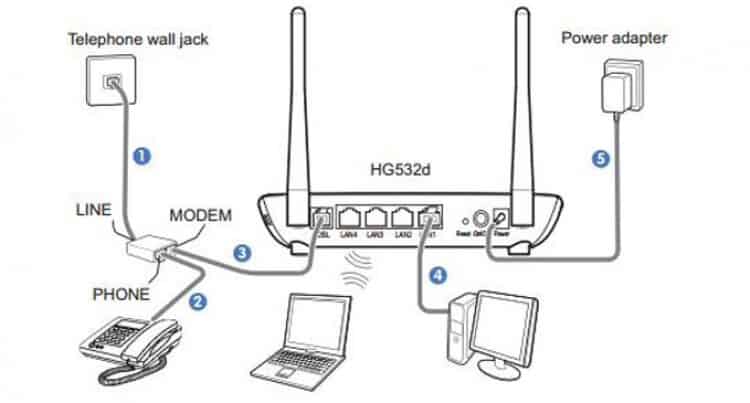What is ADSL (Asymmetric Digital Subscriber Line)?
ADSL stands for Asymmetric Digital Subscriber Line, is a telco service that provides subscribers with high-speed digital telephone services. Asymmetric Digital Subscriber Line (ADSL) is a newer technology that competes with Integrated Services Digital Network (ISDN) to provide a faster alternative to analog modems for the traditional analog local loop that joins subscribers to a telco’s high-speed digital backbone networks.
ADSL specifies how to implement high-speed, full-duplex transmission over the existing twisted-pair copper cabling of the Plain Old Telephone Service (POTS). ADSL can be used to simultaneously transmit voice and data over a single telephone line and can support high-speed Internet access for both homes and businesses. Should the data link go down, POTS voice service would still be available using ADSL.
Typical ADSL configuration

- A typical ADSL Configuration connecting HOME and TELCO CENTRAL OFFICE
- ADSL Bandwidth Allocation
How ADSL work?
ADSL is a form of Digital Subscriber Line (DSL) that enhances the data-carrying capacity of the twisted-pair copper phone lines that join most homes and offices with their local telco’s switching facilities. ADSL is asymmetric, meaning the upstream and downstream transmission rates are not equal. Over regular copper phone lines, ADSL can achieve upstream speeds of up to 1.5 Mbps and downstream speeds of up to 9 Mbps, usually in a 10:1 ratio. ADSL is therefore ideal for providing high-speed Internet access to homes and businesses where download speeds are more critical than upload speeds.
ADSL uses frequency-division multiplexing (FDM) to separate voice and data into a baseband voice channel, upstream data channel, and downstream data channel. Each channel occupies a different portion of the frequency spectrum, as shown in the illustration. The baseband voice channel is split from the data channels to guarantee phone services in case the data channel fails. Data transmission rates in the upstream direction range from 9.6 to 640 Kbps, and those in the downstream direction range from 1.544 to 8 Mbps, depending on the local loop length and wire gauge of the telephone cable. (The longer the distance, the slower the speed supported.) ADSL can use any of the following modulation systems for the data channels:
- Carrierless amplitude/phase (CAP)
- Discrete multitone (DMT)
- Discrete wavelet multitone (DWMT)
In a typical implementation, an ADSL modem is used to connect your computer to a standard analog POTS phone line. The ADSL modem contains a POTS splitter chip that splits the bandwidth of the phone line into a voice and a data channel. The data channel is split, using a channel separator chip, into an upstream and a downstream channel, with the downstream channel having the larger portion of bandwidth. The voice band uses frequencies up to 4 kHz, while the data channels use the higher frequencies. Carrying capacity depends on the thickness of the wire and other line conditions.
At the other end of the subscriber’s local loop is an ADSL modem at the telco central office. The telco’s modem separates voice from data using a splitter and routes voice calls through the POTS, while the data is routed to either a similar ADSL modem or a Digital Subscriber Line Access Multiplexer (DSLAM) unit. The DSLAM unit combines multiple ADSL lines into a single fiber-optic Asynchronous Transfer Mode (ATM) backbone connection to the Internet.

ADSL has numerous advantages over standard analog modem access to the Internet, including much higher data rates, instant connection, simultaneous voice/data over a single phone line, and greater security. The negative side is the higher equipment cost and limited availability of ADSL in current telco markets.